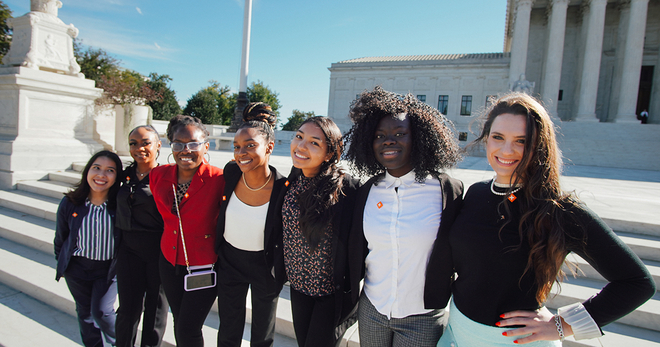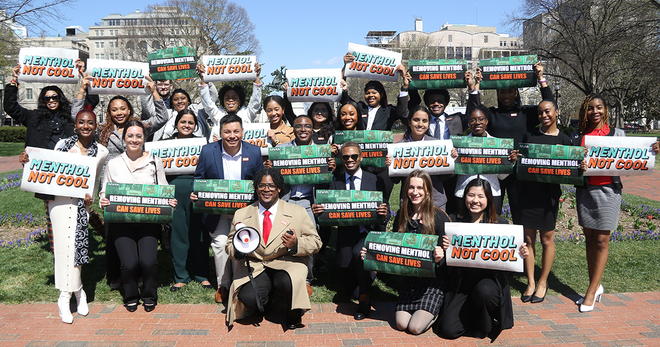Young activist focuses on helping the homeless population live tobacco-free
When Delaware native Kelsey Magill moved to Washington, D.C., she noticed the city’s large number of people experiencing homelessness—a population with less access to health care, but a greater risk of exposure to the nation’s leading cause of preventable death and disease.
Tobacco use disproportionately affects many marginalized populations, including the homeless. Magill learned this, and more about why tobacco is a social justice issue, as a participant in the 2016-17 Youth Activism Fellowship program at Truth Initiative®. During her fellowship, which requires participants to develop and implement local tobacco-control projects, Magill recognized an opportunity to help youth and young adults experiencing homelessness in the district live tobacco-free lives.
85%
85 percent of homeless-serving organizations see tobacco as an important issue.
“All young people should have access to the resources necessary to live tobacco-free lives, regardless of gender, sexuality, education level, employment status or housing situation,” said Magill, a George Washington University graduate with a bachelor’s degree in political communication. “I’m really hoping my project will put a bigger emphasis on that fact.”
Magill’s project has three goals: gain more information on the relationship between homelessness and tobacco use; raise general awareness of tobacco use rates among homeless people in Washington, D.C.; and increase access to smoking cessation and prevention resources to decrease tobacco use and initiation.
The biggest challenge of the project came before it even started. Magill said she struggled to find a local homeless-serving organization that had the time and resources to partner with her to kick off her project, despite offering free cessation and prevention support and outreach.
“I’ve come to find just how stretched thin these organizations are,” Magill said. “It’s been really eye-opening to me, and it’s backed up a lot of data that I’ve seen too: that a lot of homeless-serving organizations have a strong desire to address tobacco use with their clients, but don’t have the resources or the time to do so.”
Magill is referring to data from the National Coalition for the Homeless, which found that despite having insufficient tobacco prevention, education and cessation programs, 85 percent of homeless-serving organizations see tobacco as an important issue to address in the homeless community.
After months of networking, Magill secured a partnership with Sasha Bruce Youthwork, a youth-serving organization that provides a variety of services, including help finding safe homes and achieving and maintaining physical and mental health. The collaboration includes a plan to distribute a self-assessment survey to homeless youth and young adults that helps participants consider their tobacco beliefs and behaviors, and a training session on smoke-free environments.
Magill hopes the results of her project will inspire future initiatives that address the programmatic gaps in tobacco control efforts for the homeless population. According to Magill, the available information on tobacco use and homelessness is “significantly outdated and insufficient.”
“The underlying challenge here is that tobacco prevention and cessation, while important to this population, is competing with other primary needs like permanent housing, safety, employment and access to food,” she said. “But if we’re saying that there are higher rates of tobacco use among the homeless community, there needs to be a bigger priority placed on that population.”
People experiencing homelessness have been overlooked by many, but not by the tobacco industry— which has a long and documented history of targeting vulnerable populations. For example, in 1995, tobacco company R.J. Reynolds created a marketing strategy called “Project SCUM” (Sub-Culture Urban Marketing) to boost cigarette sales by targeting the homeless population and other groups, especially with advertisements and displays strategically placed in communities and stores. The most recent research shows that nearly three-quarters of homeless adults use tobacco.
Magill, who has been volunteering and working in tobacco control for almost 10 years, said the project and the fellowship motivated her to continue her efforts for years to come.
“My experience with this program has been very important for me personally,” she said. “Being part of this fellowship, I’ve been connected to 30 other individuals who have the same passions and the same goals as I do. Seeing them come into this has reignited my passion for the field and it showed me how much more I have to contribute to it.”
For more stories about youth activists in action, visit our Get Involved page.
More in tobacco prevention efforts
Want support quitting? Join EX Program
By clicking JOIN, you agree to the Terms, Text Message Terms and Privacy Policy.
Msg&Data rates may apply; msgs are automated.



